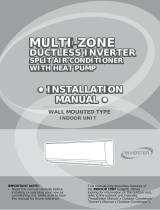
Page 18
6. Feed the signal wire through this slot, from
the back of the unit to area near terminals.
7. Facing the front of the unit, attach 4 leads of
the signal wire to the 4 terminal positions
marked as 1-2-3-G (Ground). Note the color
of the wire used for each terminal, to connect
same wire to the same position at other end.
CAUTION
DO NOT MIX UP THE WIRES BETWEEN EACH ENDS
This is hazardous, and can cause the air
conditioning unit to malfunction.
8.
After checking to make sure every connection
is secure, use the cable clamp to fasten the
signal cable to the unit. Screw the cable clamp
down tightly.
9.
Replace the wire cover on the front of the
unit, and the plastic panel on the back.
NOTE ABOUT WIRING
Step 7: Wrap piping and cables
Before passing the piping, drain hose, and the
signal cable through the wall hole, you must
bundle them together to save space, protect
them by sealing the ends, and insulate them.
1.
Bundle the drain hose, refrigerant pipes, and
signal cable according to Fig. 3.10.
Indoor Unit
Space behind unit
Refrigerant piping
Drain hose
Signal wire
Insulation tape
DRAIN HOSE MUST BE ON BOTTOM
Make sure that the drain hose is at the bottom
of the bundle. Putting the drain hose at the
top of the bundle can cause the drain pan
to overflow, which can lead to fire or water
damage.
DO NOT INTERTWINE SIGNAL CABLE WITH
OTHER WIRES
While bundling these items together, do not
intertwine or cross the signal cable with any
other wiring.
2.
Using adhesive vinyl tape, attach the drain
hose to the underside of the refrigerant pipes.
3.
Using insulation tape, wrap the signal wire,
refrigerant pipes, and drain hose tightly
together. Double-check that all items are
bundled in accordance with Fig. 3.10.
DO NOT REMOVE DUST CAPS FROM THE PIPING
When wrapping the bundle, keep the ends of
the piping sealed well with the original dust caps
or using duct tape so that dust cannot enter inside.
Leave connection points accessible for leak
and electrical checking later (see next sections).
Step 8: Mount indoor unit
If you installed new connective piping to the
outdoor unit, do the following:
1.
If you have already passed the refrigerant
piping through the hole in the wall, proceed
to Step 4.
2.
Otherwise, double-check that the ends of the
refrigerant pipes are sealed to prevent dirt or
foreign materials from entering the pipes.
3.
Slowly pass the wrapped bundle of refrigerant
pipes, drain hose, and signal wire through the
hole in the wall.
4.
Hook the top of the indoor unit onto the upper
hooks of the mounting plate.
5.
Check that the unit is hooked firmly on mounting
plate by applying slight pressure to the left and
right-hand sides of the unit. The unit should
not jiggle or shift.
6.
Using even pressure, push the bottom half of
the unit toward the wall. Keep pushing evenly
until the unit snaps onto the hooks along the
bottom of the mounting plate.
7.
Again, check that the unit is firmly mounted
by applying slight pressure to the left and the
right-hand sides of the unit.
Fig. 3.10
Indoor Unit
Installation
THE WIRING CONNECTION PROCESS MAY
DIFFER SLIGHTLY BETWEEN UNITS.
8.
During this entire process, make sure that the
copper pipes, insulation materials, drain hose,
electrical wires are not stressed, bent, kinked,
or received any stresses or damaged otherwise.





















